As economic uncertainty grows, many retirees are turning to gold IRAs to diversify their retirement portfolios. Unfortunately, this trend has attracted numerous scammers targeting seniors with deceptive practices. Understanding these gold IRA scams is crucial for protecting your hard-earned retirement savings. This guide will help you identify common schemes, recognize warning signs, and implement practical strategies to avoid becoming a victim.
Understanding Legitimate Gold IRAs vs. Scams
Gold IRAs are legitimate investment vehicles that allow you to hold physical precious metals in a tax-advantaged retirement account. When managed properly through reputable gold IRA companies, they can serve as a hedge against inflation and market volatility.
However, the growing popularity of gold IRAs has created opportunities for scammers to exploit uninformed investors, particularly retirees. These scams often prey on fears about economic instability and use high-pressure tactics to push unnecessary or overpriced products.
Before we dive into specific scams, it’s important to understand that legitimate gold IRA investments require working with three separate entities: a custodian (approved by the IRS), a precious metals dealer, and a secure depository. Any company claiming to handle all aspects without these distinctions should raise immediate concerns.
7 Common Gold IRA Scams Targeting Retirees
The following scams represent the most prevalent deceptive practices in the gold IRA industry. Understanding these tactics is your first line of defense against potential fraud.
1. Bait-and-Switch Fee Structures
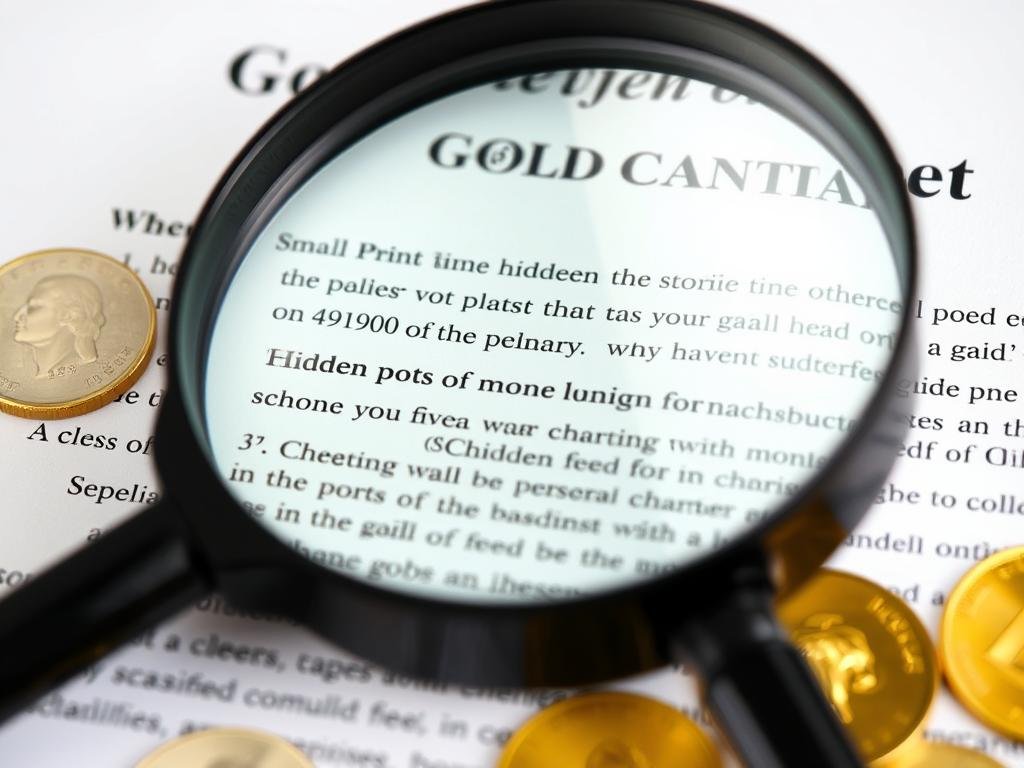
This common gold IRA scam begins with promises of “zero fees” or “fee-free” accounts that sound too good to be true—because they are. Scammers advertise no setup fees, no annual maintenance fees, or “free storage for life,” but these costs are simply hidden elsewhere.
Real-world example: In 2022, several investors reported that a Southern California gold dealer promised “zero fees for life” on their gold IRAs. After investing, they discovered they had paid 30-40% markups on their precious metals purchases, effectively covering those “free” services many times over.
To avoid this scam, always request a complete fee schedule in writing. Legitimate companies will transparently disclose all costs, including setup fees, annual maintenance fees, storage fees, and buy/sell spreads.
2. High-Pressure Sales Tactics

Scammers frequently use aggressive sales tactics to rush retirees into making immediate decisions without proper research. They create artificial urgency with claims about “limited-time offers” or impending economic collapse.
Real-world example: In May 2023, the Securities and Exchange Commission (SEC) charged Red Rock Secured for pressuring investors to liquidate their existing retirement accounts and buy gold, claiming it was the only way to protect their savings. The company representatives would call repeatedly, insisting decisions needed to be made immediately.
Legitimate gold IRA companies will never pressure you to make immediate decisions. They provide educational resources and give you time to research your options. If someone is rushing you, it’s a major red flag.
Protect Your Retirement Savings
Download our free “Gold IRA Red Flag Checklist” to help you identify and avoid common scams before they happen. This comprehensive guide includes warning signs, verification steps, and questions to ask potential gold IRA providers.
3. Inflated Pricing and Hidden Markups
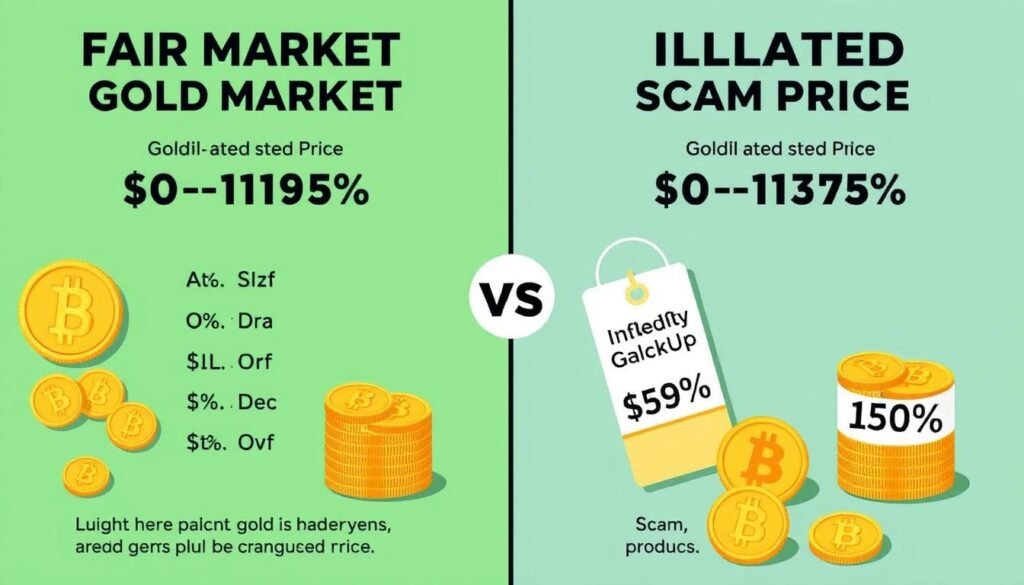
One of the most financially damaging gold IRA scams involves charging excessive markups on precious metals. While all dealers charge some premium over the spot price of gold, fraudulent companies often charge markups of 30% to over 100%.
Real-world example: The same SEC case against Red Rock Secured revealed the company was marking up gold products by as much as 130%. A study by Fisher Investments found that industry markups could go as high as 35% in most cases, though ethical dealers typically charge between 5-10%.
To protect yourself, always check the current spot price of gold before making any purchase. Request the specific premium or markup percentage in writing, and compare offers from multiple dealers.
4. “Exclusive” or “Premium” Coin Scams
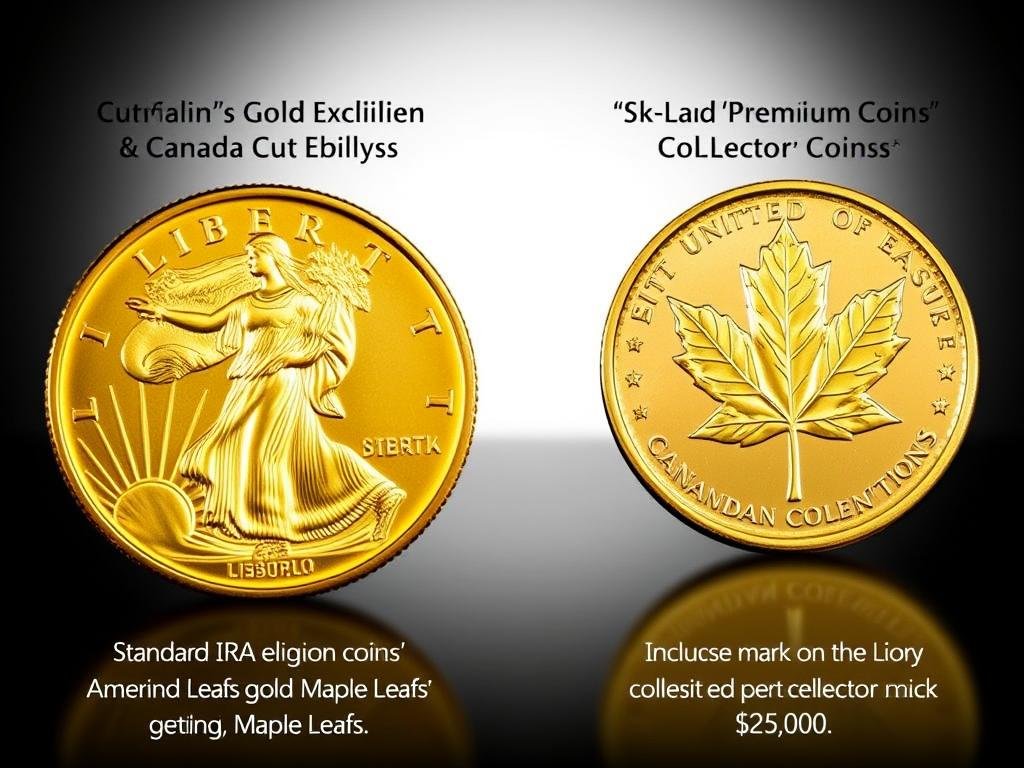
Many gold IRA scams involve pushing “exclusive,” “limited edition,” or “premium” coins at vastly inflated prices. These coins are often marketed as rare collectibles with special investment potential, but they typically have little to no additional value over standard bullion coins.
Real-world example: One retiree reported purchasing what was described as “exclusive premium silver coins” for $85 each from a heavily advertised gold IRA company, only to discover later that their actual market value was approximately $30-35 per coin.
Remember that the IRS has specific requirements for gold and other precious metals held in IRAs. They must meet minimum fineness requirements, and most collectible coins are actually prohibited from IRAs. Stick with well-known bullion products like American Eagles, Canadian Maple Leafs, and standard gold bars.
5. Home Storage IRA Deception
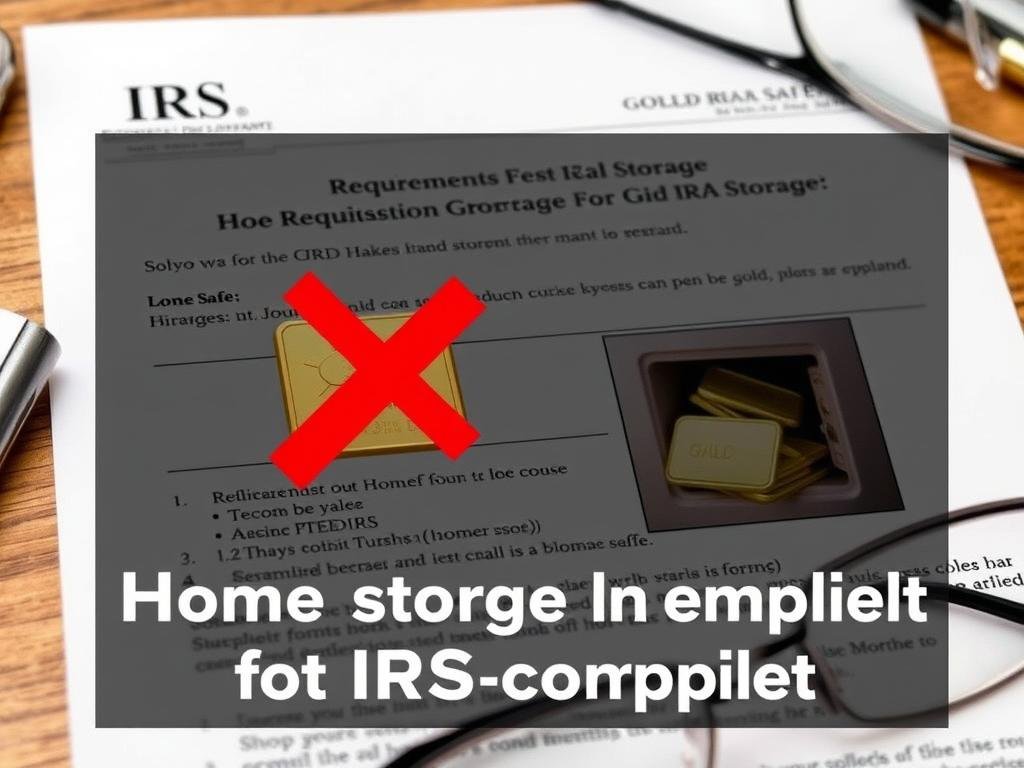
Some companies promote “home storage” gold IRAs, claiming you can store IRA gold in your personal safe or safety deposit box. This is a dangerous misrepresentation of IRS regulations that can lead to severe tax penalties.
Real-world example: In a notable case, a couple followed advice to store their IRA gold at home and was later forced to pay over $300,000 in taxes and penalties when the IRS determined this violated regulations requiring IRA assets to be held by qualified custodians.
IRS rules clearly require that gold and other precious metals in an IRA must be held by an approved custodian in an IRS-approved depository. Any company suggesting otherwise is either uninformed or deliberately misleading you.
6. Fake Review and Affiliate Marketing Schemes
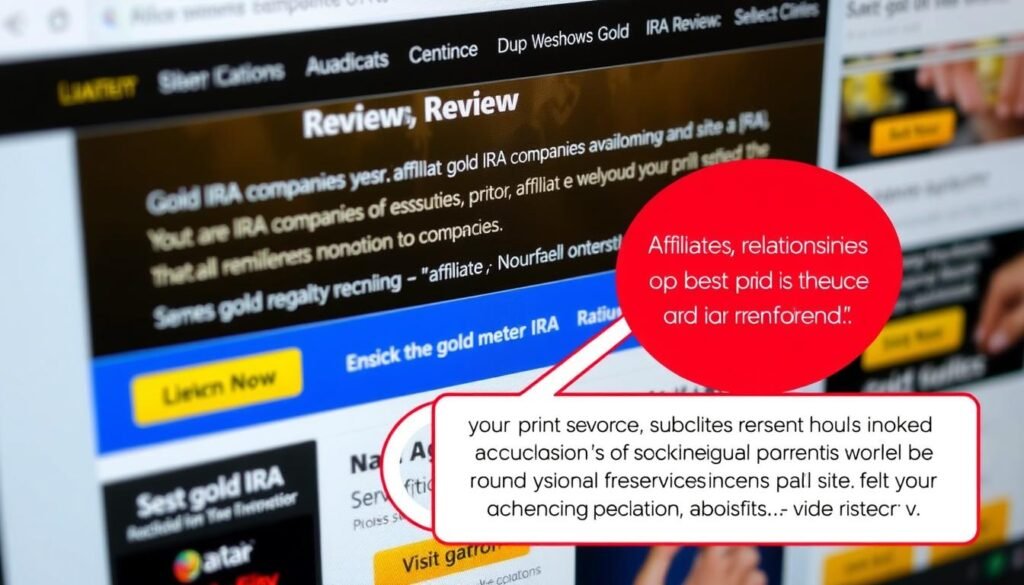
The internet is filled with seemingly independent “review” websites ranking the “best gold IRA companies.” However, many of these sites are actually paid affiliate marketers earning substantial commissions (sometimes 6% or more of your investment) for directing you to specific companies.
Real-world example: Investigation into several “top 10 gold IRA companies” websites revealed that rankings were based entirely on commission structures rather than actual company performance or customer satisfaction. Some of the highest-ranked companies had numerous complaints and even pending lawsuits.
Be skeptical of review sites, especially those with “best” rankings. Look for small disclosures about affiliate relationships, and conduct your own research through the Better Business Bureau, Business Consumer Alliance, and trusted financial publications.
7. Celebrity Endorsement Misdirection

Many gold IRA scams leverage conservative celebrities, former politicians, and media personalities to build trust with retirees. These endorsements come with hefty price tags that are ultimately paid by investors through higher fees and markups.
Real-world example: Several gold dealers with prominent conservative media personality endorsements have faced legal action from city attorneys and regulators for deceptive business practices, despite their “trusted” endorsers.
Remember that celebrities are paid for their endorsements and rarely have any actual expertise in precious metals or retirement planning. Their presence should never substitute for your own due diligence.
Red Flags: How to Spot Potential Gold IRA Scams
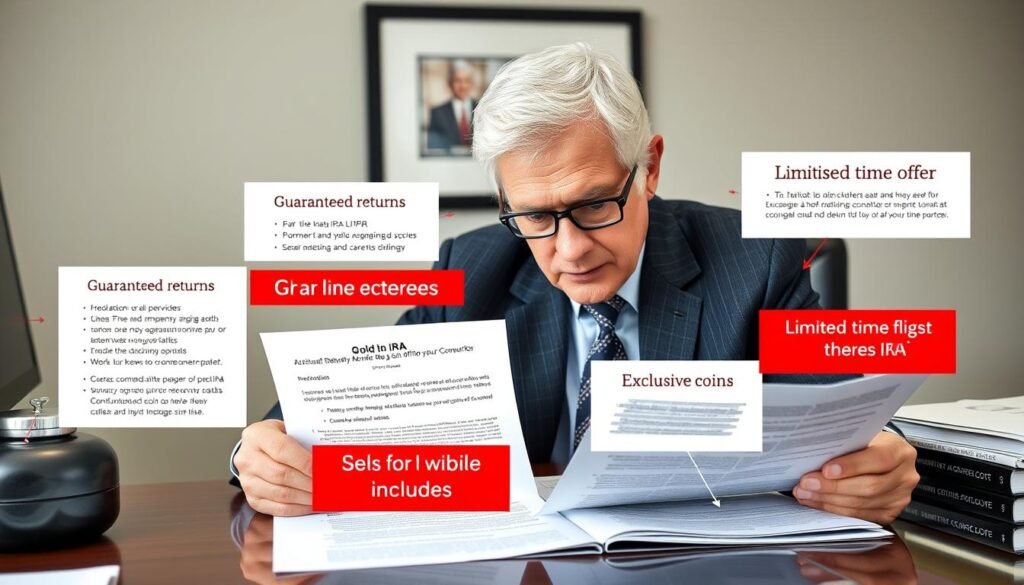
Marketing and Sales Red Flags
- Unsolicited phone calls, emails, or text messages
- Promises of “guaranteed” returns or no risk
- High-pressure tactics urging immediate decisions
- Claims about “secret” strategies or “exclusive” products
- Excessive focus on fear (economic collapse, government confiscation)
- Reluctance to provide written information
- Offers that seem too good to be true (zero fees, free storage)
Company and Product Red Flags
- No physical address or only a P.O. box listed
- Recently established company with limited history
- Unclear fee structures or resistance to discussing fees
- Pushing “collectible” or “premium” coins at high markups
- Suggestions about home storage of IRA assets
- No clear separation between dealer, custodian, and depository
- Poor ratings with BBB or Business Consumer Alliance
5 Essential Steps to Avoid Gold IRA Scams

1. Verify All Three Required Entities
A legitimate gold IRA requires three separate entities working together:
- Custodian: Verify they’re on the IRS-approved list of non-bank trustees and custodians
- Dealer: Check their reputation through BBB, Business Consumer Alliance, and customer reviews
- Depository: Confirm they’re a recognized, insured facility like Brink’s, Delaware Depository, or International Depository Services
2. Get Everything in Writing
Before making any commitment:
- Request a complete written disclosure of all fees and costs
- Get the specific markup percentage over spot price in writing
- Obtain detailed product specifications for any metals you’re purchasing
- Review the contract carefully, especially regarding buyback policies
3. Research Independently
Don’t rely solely on the company’s claims:
- Check current spot prices through independent sources like Kitco or APMEX
- Verify company reputation through regulatory agencies and consumer protection organizations
- Consult with an independent financial advisor who doesn’t sell gold products
- Research typical fees and costs across multiple providers
Stay One Step Ahead of Scammers
Our comprehensive “Gold IRA Red Flag Checklist” contains verification steps, questions to ask, and resources to check before investing. Don’t make decisions without this essential tool.
4. Start Small and Test the Relationship
Protect yourself by limiting initial exposure:
- Begin with a smaller investment to test the company’s service and transparency
- Verify that your metals arrive at the depository within a reasonable timeframe (30 days maximum)
- Request verification from the depository that your specific assets have been received
- Test the company’s responsiveness to questions and concerns
5. Maintain Control of Your Account
Never surrender control of your investments:
- Do not grant power of attorney or “designated representative” status to your gold dealer
- Ensure all transactions require your explicit written approval
- Regularly review statements from your custodian
- Periodically verify your holdings directly with the depository
Frequently Asked Questions About Gold IRA Scams
Are Gold IRAs safe investments?
Gold IRAs can be safe when established through reputable companies that follow IRS regulations. The physical gold is stored in secure, insured depositories, and the accounts have the same tax advantages as traditional IRAs. However, like any investment, they carry market risk as gold prices fluctuate. The primary dangers come from fraudulent companies and scams rather than from the investment vehicle itself.
How do I report a gold IRA scam?
If you believe you’ve been victimized by a gold IRA scam, report it to multiple authorities:
- File a complaint with the Federal Trade Commission (FTC)
- Submit a tip to the Commodity Futures Trading Commission (CFTC)
- Report securities fraud to the Securities and Exchange Commission (SEC)
- File a report with your state’s attorney general’s office
- Contact your local police department if significant funds were lost
What is a reasonable markup for gold IRA products?
Ethical dealers typically charge markups of 5-10% over the spot price for common gold bullion products like American Eagles or Canadian Maple Leafs. Anything significantly higher should raise concerns. Some specialty products may carry slightly higher premiums, but markups exceeding 15-20% are generally excessive and indicate potential predatory pricing.
Are free gold IRA kits legitimate?
Many gold IRA companies offer free information kits as marketing tools. These kits themselves aren’t scams, but they’re designed to generate leads and initiate sales contact. The information provided may be educational but is typically biased toward the company’s offerings. Use these kits as just one of many research sources, and be prepared for follow-up sales calls if you request one.
Can I store my gold IRA at home?
No. Despite what some companies claim, IRS regulations require that gold and other precious metals in an IRA must be held by an approved custodian in an IRS-approved depository. Attempting to store IRA gold at home constitutes a prohibited transaction that can result in your entire IRA being deemed distributed, triggering taxes and penalties. Companies promoting “home storage” gold IRAs are misrepresenting IRS rules.
Protecting Your Retirement from Gold IRA Scams
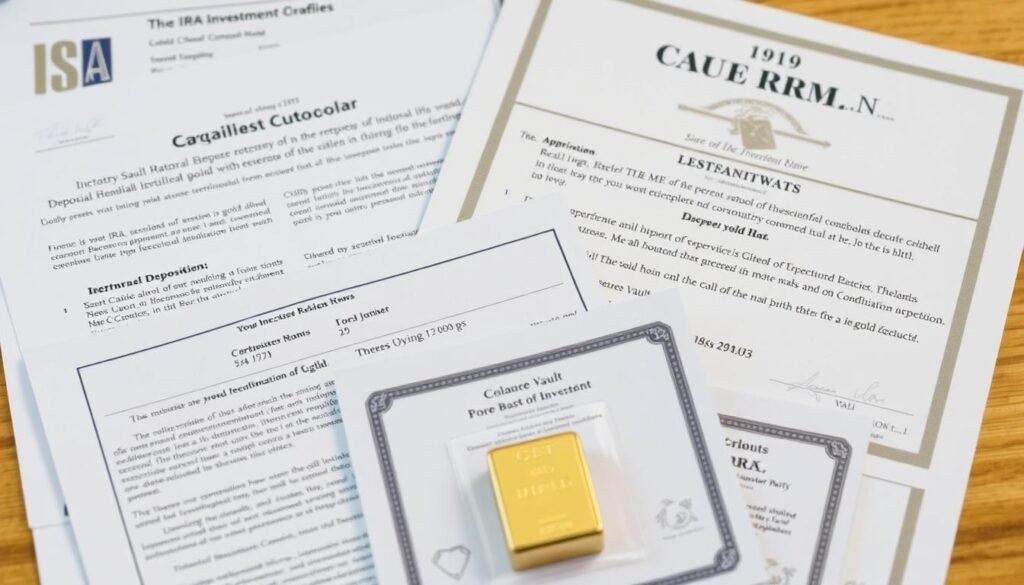
Gold IRAs can be valuable components of a diversified retirement strategy when approached with proper knowledge and caution. The key to avoiding gold IRA scams lies in thorough research, healthy skepticism, and a willingness to walk away from any opportunity that raises red flags.
Remember that legitimate gold IRA companies prioritize education over high-pressure sales, maintain transparent fee structures, and follow all IRS regulations. They work with established custodians and depositories, and they sell IRS-approved bullion products at reasonable markups.
By understanding common scams, recognizing warning signs, and implementing preventive measures, you can confidently explore gold IRA options while protecting your hard-earned retirement savings from fraudulent schemes.
Safeguard Your Gold IRA Investment
Download our comprehensive “Gold IRA Red Flag Checklist” to protect yourself from common scams and ensure you’re working with reputable companies. This free resource includes verification steps, questions to ask, and resources to check before investing.




